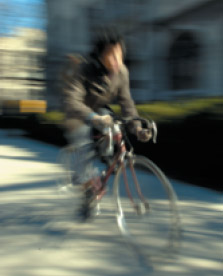|
||
     |
Cycle into spring
March brings the telltale signs of a Chicago spring: temperatures ricochet from 50 degrees to 20, the lichen glows green on tree trunks while the grass remains brown, and even on a sunny but frigid Wednesday morning there are only a few spaces to be had among the Regenstein Library bike racks. A cold wind whips the bare calf of a student pedaling past, his pant leg carefully folded up and away from chain grease, while a young woman pulls her scarf up over her nose and bikes away to hand in a paper due “right now.” Chicago has always had its share of hardy winter cyclists, but in spring a campus comes alive with bikes, the racks get tight, and any spare signpost or slender tree becomes host to two wheels and a lock.

Third-year Dinesh Sabu whizzes through
the quads on a cold March day.
No statistics are available as to whether campus cycling has increased in recent years, but circumstantial evidence—how difficult it can be to find a parking spot and how facilities keep up with demand—suggests bike use is on the rise. The Hyde Park campus now has 1,565 spaces at 44 locations. Operations & Maintenance will install 150 more spaces this year, including ones already near Rosenwald, Walker, and Jones. Shiny, black, continuous-curve racks also undulate outside the new business school and the Ratner Athletic Center. In October students made a minor huff when the University Police began clipping locks and impounding bikes locked to building-ramp handrails, part of a push to comply with the Americans with Disabilities Act, which requires accessible handrails.
Meanwhile, the Big Friendly Bike Club, a student organization founded in 2002 by Arline Welty, AB’04, is still going strong, hosting organized rides, sales, and repair workshops. Current president Val Brostrom, AB’00, a second-year at Pritzker, believes she saw more people out on bikes this past winter than in previous years, “but then I may be more in tune to it.”
Students and staff offer typical reasons for choosing to bike even on a blustery spring day. “It’s the ideal form of transportation year-round. It beats walking, and the price beats driving,” says Ross Eiler, AM’04, a third-year Divinity student who steps out of Cobb Hall with a white bike helmet strapped to his backpack. “I’d rather be very, very cold for two minutes than very cold for 20.” Outside the Reg Steven Lane, a digital-library Web designer who lives nine miles from campus, says he sold his car in 1998 and has been a cycling commuter ever since. Lane shrugs, “It’s easier to get around.”
Mayor Richard M. Daley’s oft-stated goal to make Chicago the nation’s “most bike-friendly city” has upped cycling’s attractiveness for some students and staff during winter or for long distances; this year the Chicago Transit Authority equipped buses with front-loading bike racks. “When it’s really freezing outside,” Lane says, “I only have to ride three miles to the bus stop, and then it’s a warm 30-minute ride to the Reynolds Club.”
Of cycling’s campus boosters, the most visible, perhaps, is Dean of the College John Boyer, AM’69, PhD’75, who pedals around Hyde Park in every type of weather “except pack ice.” For many years Boyer has encouraged students to “buy a bike and use it, as opposed to these big noisy buses.” A historian of the Hapsburg Empire, he considers bicycling “our last link to the 19th century. People don’t take trains or ride barges or ships or horses much anymore. But bicycles are still here.”
Boyer’s hopes and circumstantial evidence aside—the increased number of College students, from 3,550 a decade ago to 4,400 today, he points out, could explain the demand for more bike racks—he doubts that cycling has increased significantly on campus. “It’s like effecting any other kind of change around here,” he says, as slow as “turning an ocean liner.”
But Welty, now at the Chicagoland Bike Federation (CBF), a nonprofit organization that works with the city and local colleges and universities to promote bicycling, has seen definite change. The director of CBF’s corporate and foundation relations, she says the group’s bike-repair workshops and twice-annual used-bike sales are always “swamped,” and she expects a high turnout at this spring’s events, which she’s helping to coordinate. “Cycling is my life,” she says. “I encourage people to see the amazing potential for bicycling at Chicago.” Boyer and his bare-calf compatriots couldn’t agree more.